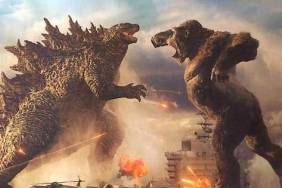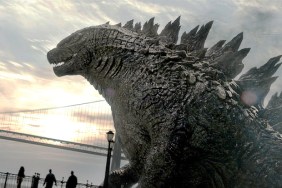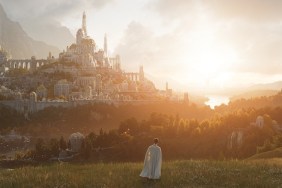This is the fifth week in my epic Summer of Godzilla (part of the most ambitious and lengthy challenge in The Series Project) and I have hit a snag, dear readers. This was the week I intended to finish off the Showa period of Godzilla movies (i.e. the first Godzilla continuity) with Terror of Mechagodzilla from 1975, and ring in the Heisei era with the one-two punch of The Return of Godzilla from 1984, and its American counterpart Godzilla 1985. This was also the week I was to ring in the new Godzilla design, which was introduced in 1989’s Godzilla vs. Biollante, wherein our famed monster does battle with a giant mutant rose bush.
I was able to track down all of the Godzilla movies to date, save one. Oddly enough, The Return of Godzilla (1984) has not been released in America in its original form through theaters or any form of home video. It is also not available through any sort of online rental or streaming option – and yes I probably tried the site you were about to suggest. Illegal downloads proved to be sketchy, and the one locale that could have provided me with a mail-order bootleg DVD naturally (and I’m guessing unwittingly) gave my credit card information to a thief in China who has stolen a good $650 from me. The DVD is still on its way, the theft is being dealt with, and all is well, other than the fact that I have a glaring gap my Godzilla continuity. By next week, I will have seen The Return of Godzilla, and I will continue with The Summer of Godzilla, Part 5 then, but for the time being I feel it would be irresponsible to continue the series with such an important film missing. The Return of Godzilla is essentially the first film in a new Godzilla series, and establishes not only the story precedent for the following adventure with Biollante, but was also the model for Godzilla 1985 in the exact same way the original Gojira served as the model for Godzilla, King of the Monsters! It was the lynchpin of this week’s installment, and I cannot responsibly continue until I fill in that gap. I apologize to my readers for the delay, but I assure you that it is necessary.
Luckily for you, I am not totally out of material. I did watch an ancillary Godzilla movie in the meantime which I feel needs to be addressed in the greater Godzilla canon, and is often not considered part of the Godzilla continuity. I refer, of course, to Marv Newland’s 1969 short film Bambi Meets Godzilla. This is slightly out of chronological order, but an necessary stop on the way. I will also be talking about several other animated adventures of Godzilla that can be hung on the main series as we go along. This week’s installment of The Summer of Godzilla will be an intermission, but also an orienteering course.
Bambi Meets Godzilla


Release Date: 18th April, 1969
Monster: Bambi
Description: Small timid fawn
Origin: Raised in the woods by Mrs. Bambi
Destruction: Stomped to death.
Bambi Meets Godzilla was constructed by a hardworking film student, Marv Newland, who reportedly couldn’t finish his live-action student thesis film on time, and rushed Bambi Meets Godzilla into production, completing in by himself in two weeks time. I wasn’t not able to find anywhere what kind of grade Mr. Newland received on his film, but Bambi Meets Godzilla has nonetheless become one of the great animated short films of all time, talked about to this very day by lovers of off-the-wall films and bonkers animation. This film regularly makes animated film festival appearances, has been released on several different home video compilation films (I first saw it as a bonus film on the Hardware Wars VHS). Bambi Meets Godzilla made its American commercial theatrical debut in 1985 as the introductory short before Godzilla 1985.
Running a mere 90 seconds, Bambi Meets Godzilla depicts Bambi (first introduced in David Hand’s 1947 animated feature Bambi), a placid and adorable fawn, alternately feeding on flowers and regarding the sun. The serene music of the opening of The William Tell Overture plays on the soundtrack. Then, in the film’s climax, Godzilla steps on Bambi. Bambi dies tragically and unexpectedly. Then Godzilla wiggles his toenails, an ability he has not demonstrated until this moment. He will not wiggle his toenails in any future Godzilla film.
Bambi Meets Godzilla is a comedy classic for several reasons. Bambi Meets Godzilla is so well known and widely watched, that we all kind of know the punchline (or perhaps stompline), don’t we? Watch it on YouTube sometime, and tell me you couldn’t see the ending coming. The film reveals a basic truth about comedy that is often argued against in comedy classes. Comedy, any professor will argue, is about surprise. Some kind of shock or punchline that reverses a well-known premise or comedic setup. A punchline is called a punchline because of its punch-like effect. Bambi Meets Godzilla eschews the notion of surprise by displaying exactly what we know is coming in a perfectly expected way. And yet it still makes the audience laugh. The juxtaposition, the sudden violence, and the timing is enough to get laughs. It doesn’t matter that you know it’s coming. That it happened – and that it happened so well – was enough. The next time a comedian tells you that comedy is all about surprise or shock, you’ll know they haven’t seen Bambi Meets Godzilla.
For another thing, Bambi Meets Godzilla is one of the earliest examples of pop cultural juxtaposition. It was made in 1969, which was long before multi-character mashups were a thing (the Universal multi-monster fests like House of Dracula notwithstanding). Bambi meeting Godzilla – on film! – was the first stretch of ridiculous imagination that the cinema had seen. These days, thanks to hugely expensive multi-film deals like Harry Potter and The Avengers and even Freddy vs. Jason, it’s almost expected that pop cultural movie characters should eventually meet and do battle at some point in their careers; it almost seems inevitable that there will eventually be a Justice League feature film, doesn’t it? In 1969, this was not common. Bambi was not expected to live in the same universe as, say, the Fox and the Hound, and fans would merely speculate as to what would happen if they met (my guess is The Fox would eat Bambi). Bambi Meets Godzilla torn down that wall, and established that any fictional character could live in the same universe as any other fictional character.
Bambi Meets Godzilla also bafflingly establishes that the Bambi movies (including the 2006 straight-to-video film Bambi II) are in line with Godzilla canon. Actually, since Bambi came first, maybe Godzilla is part of the Bambi canon. That means Yog the Space Amoeba, Rodan, and War of the Gargantuas are all of a piece with Bambi and Bambi II. I suppose this makes sense. After all, aren’t all these movies about monstrous intelligent animals? Bambi and Minilla are just the only ones who can speak English (or Japanese) in this world. I think Bambi Meets Minilla would have been a fantastic follow-up. Or the most obnoxious film of all time. I can’t decide.
There was, however, a follow-up to Bambi Meets Godzilla in 1999…






